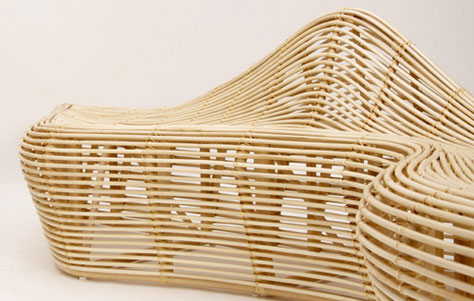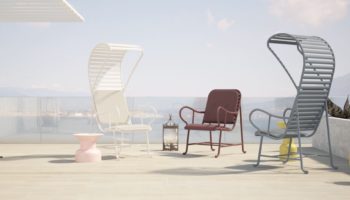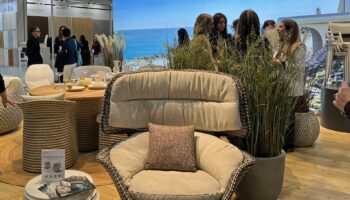Alvin Tjitrowirjo’s Linger Outdoor Bench
You may have noticed that a certain familiar, woven, all-purpose material for outdoor furnishings goes by more than one moniker. In fact, we seem to bandy about the notions of “rattan,” “wicker” and “cane” with equal and interchangeable abandon, as if they were each merely variations on a sonorous theme. Well, I—along with a clever Indonesian designer named Alvin Tjitrowirjo—intend to put a stop to all that, at least where the truth of rattan is concerned. Tjitrowijo’s weapon in the war against terminological imprecision is his impressive Linger Outdoor Bench; mine are merely my computer and my wits, whereby such helpful virtual folks as Java’s CV Aurora Rattan have provided me with the following: “Most rattans are distinct from other palms in having slender stems 2–5 cm diameter with long internodes between the leaves; their consequent growth habit also differs, not being trees but vine-like, scrambling through and over other vegetation.”
Linger. Designed by Alvin Tjitrowirjo.
Turns out rattan is a spiritual cousin to bamboo. Though technically a species of palm, rattan has a viny, grassy habit, growing in great, messy, weedy loops around other vegetation (sort of like ropes slung across trees). Like bamboo, they are a fast growing/self-replenishing species, and, what’s more, rattan only grows among established trees, thereby providing an incentive for maintenance of forests as well as an economically viable alternative to felling large trees. So that’s my environmental/pedagogical spiel for the benefits of this material. I’ll leave it to Tjitrowirjo to expound on its aesthetic allure, an objective he achieves soundlessly by the mere presentation of his enticing Linger.



The piece employs rattan exclusively, featuring differing widths of rattan “core” (the part that’s left after the rougher, outer bark is peeled away) woven together with rattan fiber (leftover shreds from the outer bark). And the weaving is beautifully executed indeed. Tjitrowirjo chose the name for his piece wisely, since not only do the sculptural contours encourage bodily lingering—the piece invites wholesale lounging in addition to tactile, fingertip exploration—but also a kind of covetousness of the eye, as you’re mesmerized by the organic undulations of each one of the elegant rattan poles that constitute the piece.
Linger is a veritable coup for Tjitrowirjo. Since Indonesia is effectively the birthplace of the material (once supplying up to 90% of the world’s rattan), the medium has homespun roots. Tjitrowirjo’s achievement with Linger is no less than ushering a venerated craft of a local resource into the contemporary age. And all this with a very environmentally friendly species of wood. The world should definitely sit up (or lounge back languorously) and take notice.
Via Industrial Design.




Leave a Reply